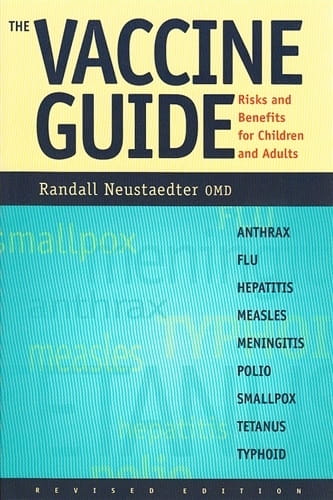Reprinted with the permission of The Society of Homeopaths, (from "The Homeopath" Journal July 2003). Reviewed by Francis Treuherz
This is a new revised edition of what has become one of the standard books on this subject. The author has added information about childhood and adult immunisations and included material about the new growth industry of anti-terror measures, some of which may be as dangerous as the terror itself.
"All vaccines carry risks of adverse reactions. Every parent has the legal right to exempt children from vaccination. The vaccination campaign has traded the infectious diseases of childhood for chronic autoimmune diseases that afflict both children and adults." These are the banner headlines of this book. The rest is fascinating and gruesome detail.
The first part of the book, some 130 pages, is, in large part, concerned with our ability to make informed choices about both childhood and adult vaccines. There is a discussion of both the short and long term adverse reactions to vaccination, in which conditions such as autism, immune system disorders, multiple sclerosis " and diabetes are examined. There is information about contaminated vaccines -monkey virus, HIV, cancer, and dangerous chemicals like thimerosal, formaldehyde and aluminium. The conventional vaccines are described and there is a wealth of ideas about alternatives, and the legal issues (more relevant in the USA). He is as rigorous in his critical descriptions of alternatives as he is about the conventional vaccines; in fact I think he dispels some urban myths' about so-called homeopathic prophylaxis, which some homeopaths hold dear.
In the second part of the book the vaccines are described. Now included are anthrax, diphtheria, hepatitis, influenza, lyme, measles, meningitis, mumps, pertussis, polio, rubella, smallpox, tetanus, typhoid and varicella. There is more information in this edition for travellers. There is enough detailed and clearly presented information here, about potential reactions and alternative strategies for each vaccine, for an individual to be able to reach a decision about each one. There are helpful lists of resources references and an index.
The main focus of this book is to provide information for our patients, so that more informed decisions may be made about vaccinations. We may have our own views, but in our role as the unprejudiced observer we cannot make decisions for our patients, nor force our views upon them. Instead we can lead them to consider all sides of the argument and suggest reading for them. If you are looking for a totally unbiased review of the vaccination issue then this is not the book for you.
However, it can have a place in the debate. The author is clear about his stance and the book is passionately written. Vaccination has become a highly emotive issue for many people, particularly parents of young babies who are faced with making some very difficult decisions. This book is blunt in its portrayal of the devastation that vaccination can cause, inciting both sadness and anger.
Although the book is obviously not free from bias, the author does attempt to take a wide view of the current situation in America. He considers the impact of vaccination from many angles: from the money-orientated motives of the pharmaceuticals and the orthodox correctness of the politicians, to the vulnerability of those parents who feel their children may be at risk.
The Vaccine Guide is surprisingly readable despite the vastness of this field and the potentially turgid and macabre nature of this catalogue of woes. To me it sums up the central dilemma of the ethics of allopathy. At least do no harm' has become submerged in global pharmaceutical commerce and politics, leaving the hapless, well-intentioned medical doctor as much a victim of the system as the patient, due to the fact that neither has been trained in any meaningful therapeutic alternative. Instead of weeping and wailing and wringing our hands, however, we have an impressive volume of alternative information here, both for our patients and for their medical doctors.
As homeopaths we can help with rapid, gentle cure by giving our patients the tools for their self preservation, and also by broadcasting the knowledge that homeopathy can be an enormously useful treatment for these major infectious diseases. But it has to be the patients' choice. This book may be one of the keys to making that choice an informed one.

